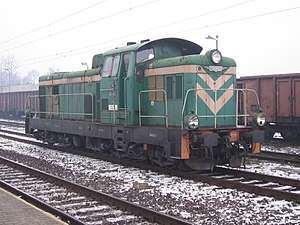PKP class SM42
SM42 is the PKP class for a Polish road switcher diesel locomotive for shunting and light freight traffic, built by Fablok in Chrzanów (manufacturer's designation is Ls800E, designer's designation 6D).
| SM42 | |||||||||||||||||||||||||||||||||||||||
|---|---|---|---|---|---|---|---|---|---|---|---|---|---|---|---|---|---|---|---|---|---|---|---|---|---|---|---|---|---|---|---|---|---|---|---|---|---|---|---|
 SM42-292 at Bochnia on 26 November 2005, in the class' typical Polish livery | |||||||||||||||||||||||||||||||||||||||
| |||||||||||||||||||||||||||||||||||||||
| |||||||||||||||||||||||||||||||||||||||
| |||||||||||||||||||||||||||||||||||||||
| |||||||||||||||||||||||||||||||||||||||
History
The SM42 was the first Polish-designed heavier diesel locomotive and was the most in its country of origin.
Introduction
The technical documentation for this locomotive was developed in 1958-1962 by the state Central Construction Bureau of Railway Stock Industry (CBKPTK) in Poznań, as type 6D. The production was given over to the Fablok Locomotive Factory in Chrzanów, where it was designated Ls800E (meaning an 800 HP diesel locomotive with electric transmission). The prototype was ready in December 1963. It was lent to the Polish State Railways (PKP), as the SM42-001, the class designation 'SM' meaning a diesel shunter locomotive, and was tested in Warsaw in 1964.[1] Two improved locomotives were built for the PKP in 1964, and twenty in 1965. In 1967, the locomotive entered serial production and 1,822 were built until production ceased in 1992.[1] During the long production run, some minor improvements were incorporated into the design. The locomotives produced from 1972 onwards (so-called batch 2) had simplified chassis (starting from SM42-521, bu.no. 8499).[1]
The main buyer of Ls800 locomotives, which had priority in orders, were the Polish State Railways, which received 1157 locomotives.[1] They were used for shunting, local freight traffic and local passenger traffic in warm months. 622 were made for the Polish industry, some in Ls800P variant with single steering only[1] (they were designated by their users as Ls800 or SM42, with numbers above 2000).
A variant of type 6D/SM42 locomotive was a type 101D locomotive, with steam heating for passenger trains. Further 268 locomotives of this variant were built and classified as PKP class SP42.[2]
Later modifications
In 1972, a new version (6DM) was developed specifically for Moroccan railways (ONCFM). 37 were delivered as class DG 200 in 1973-1975. The main difference with respect to the original design was better anti-dust insulation of the machine compartment.[1] Six similar locomotives, type 6DI, were built in 1982 for Dromex, a Polish building company operating in Iraq.[1]
In the years 1975-1977, forty locomotives were converted to SU42 ("diesel universal") class, with the addition of 500 V electric heating for passenger wagons. Due to withdrawal of such wagons, in 2000 these locomotives were reclassified back to SM42.[1] Another 40 SU42 locomotives, with 3000 V heating, were converted in the years 1999-2000 from PKP class SP42.[2]
Nicknames
This locomotive has also been referred to by the following nicknames:
- Zebra or Stonka (eng. Colorado beetle) - from the livery
- Wibrator (eng. Vibrator) - from the vibrations the engine produced
- Eleska - from the factory number: Ls800
- Fablok - from the producer
See also
- Polish locomotives designation
References
- Pokropiński, B. (2009), pp.96-100.
- Pokropiński, B. (2009), p.110.
- Bogdan Pokropiński, Lokomotywy spalinowe produkcji polskiej (Internal combustion locomotives of Polish production), Warsaw, 2009, ISBN 978-83-206-1731-3 (in Polish)
External links
| Wikimedia Commons has media related to Fablok 6D. |
- SM42, SP42 and SU42 – article with photos and technical data
- SM42 picture gallery